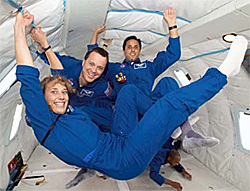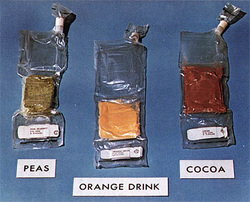Module 1 - Life in Space
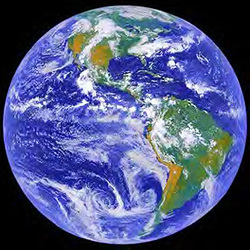
Humans have lived on Earth for thousands of years. Earth is
a comfortable place. It supplies us with everything we need to live. Some of
these include:
What would life be like if we lived in space? Now, we’re not talking about living on another planet. What if we actually lived in space? How would we do that?
- A stable atmosphere with enough oxygen for us to breathe.
- Plenty of fresh water for us to drink. This water is constantly renewed and recycled through the water cycle.
- Comfortable temperature. Because Earth is located an ideal distance from the Sun, we have a comfortable temperature for most of the year.
- Food. Earth is full of food. Whether it comes from fruits and vegetables or animals, there is food.
- Energy. We know the Sun is the ultimate source of all energy on Earth. We can even capture the Sun’s energy directly as solar power. The Earth also has other forms of energy, such as wind power, geothermal power (heat from underneath the Earth) and fossil fuels like gasoline and oil.
- Gravity. We don’t think much about gravity, but it is extremely important for life on Earth. Without gravity, we would float off the Earth. If there was too much gravity, we would be crushed. If there was less gravity, we would have a difficult time moving around and our bodies would become weak.
What would life be like if we lived in space? Now, we’re not talking about living on another planet. What if we actually lived in space? How would we do that?
Life on a space colony or space station would be different
from life on Earth. We would have to find a way to meet all the needs of humans
and make them as comfortable as possible. After all, who would want to live in
space for a long time if they were going to be uncomfortable the whole time?
Before we can talk about what a space colony would have to look like or do to make life comfortable, we need to understand what happens to the human body in space.
Before we can talk about what a space colony would have to look like or do to make life comfortable, we need to understand what happens to the human body in space.
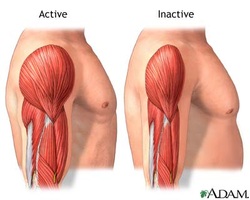
This image shows the effects of microgravity on muscles over a long period of time. The muscle on the left is the normal muscle. The muscle on the right is after being in space for a long period of time. Also notice how fit the body on the left is and how much fatter and flabbier the body on the right looks. This is because gravity is no longer helping to develop strong muscles.
Image credit: http://colonyworlds.com/wp-content/uploads/muscleloss.jpg
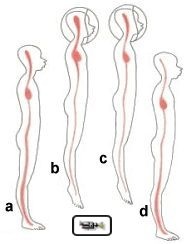
This diagram shows the effects on the cardiovascular system (blood system) in space. Figure A represents the normal body on Earth. Figures B and C represent the body in space over long periods of time. You can see more blood moving to the head and less to the lower body parts. Figure D represents the body after returning to space. The blood never quite returns to all the body parts in the same way it was before the body left Earth.
Physical Challenges
Our bodies develop the way they do largely because of the
effects of gravity on our bodies here on Earth. Gravity pushes down on us and
we have to push back against gravity. Think about a baby trying to walk. It’s
not easy for them. They have to develop a lot of extra muscles and learn how to
balance so they can walk. They are fighting against gravity. Eventually they
will win because the body will get stronger and the baby will discover balance
through trial and error.
If we lived in space, on a space colony, we would have very little gravity. It’s impossible to have no gravity because gravity exists everywhere, even if it is very tiny. When you are in the middle of space, we call that type of gravity microgravity. Microgravity literally means “little gravity.” There is hardly any gravity in the middle of space because you are not close enough to any large objects for there to be gravity.
Humans have a difficult time in microgravity. For starters, there is nothing to hold you down. Astronauts who unbuckle from their seats after getting into space, start to float around the space shuttle. There is such little gravity, that they can float around, and if they’re not careful, they will bump into the walls of the space shuttle. Astronauts have to learn how to move around. They have to move carefully and slowly, bending their bodies in new ways. It doesn’t take them that long to figure it out, but it’s confusing at first.
Another problem with microgravity is how it affects muscles. We build many of our muscles on Earth by fighting against gravity. Think about it: when a weightlifter lifts up weights, he’s not only fighting against the weight itself, he’s also fighting against gravity. In space, it would be much easier to lift those weights because there would be hardly any gravity pushing down on those weights. If you never have to fight against gravity, what would happen to your muscles? That’s right, they would become very weak.
Astronauts who live in space for a period of time find their muscles very weak when they return to Earth. In space, there isn’t even enough gravity for a person to walk. Some astronauts who live on the International Space Station return to Earth and can’t even walk because their muscles have become so weak. They have to get used to Earth’s gravity again and relearn how to walk.
A second physical problem is how the blood and heart operate in space. Gravity pushes our blood down from our heart to the rest of the body (this is one of the reasons the heart is located so high up in the body). In space, however, the blood tends to move up, meaning more blood goes toward your upper chest and head than to the rest of your body. The long-term effect of this means you will produce less blood and your heart will get smaller. Returning to Earth, you will find your heart not as strong as it needs to be.
One of the great benefits on Earth is the protection we get by our atmosphere. It protects us from the harmful radiation of the Sun, but allows us to go outside and enjoy the warmth of the Sun. The Sun also provides certain vitamins for our bodies, like Vitamin D. In space, there is no protective atmosphere. Astronauts constantly worry about radiation from the Sun getting through their space craft and causing damage to their bodies. Also, the Sunlight comes in either too powerfully or too weak for the body to receive much sunlight, which means the body will miss some of the nutrients it gets from the Sun.
Speaking of nutrients, food and digestion in space are a little different. On Earth, when you chew food, you swallow it and gravity helps the food move through the digestion system. In space, there isn’t gravity to assist with this process, so it makes it difficult to digest heavy foods. Astronauts eat a special type of food that is in a liquid form, kind of like toothpaste. It doesn’t taste like toothpaste, but it feels like it. If you had to eat that all the time, you’d probably get pretty tired of it.
If we lived in space, on a space colony, we would have very little gravity. It’s impossible to have no gravity because gravity exists everywhere, even if it is very tiny. When you are in the middle of space, we call that type of gravity microgravity. Microgravity literally means “little gravity.” There is hardly any gravity in the middle of space because you are not close enough to any large objects for there to be gravity.
Humans have a difficult time in microgravity. For starters, there is nothing to hold you down. Astronauts who unbuckle from their seats after getting into space, start to float around the space shuttle. There is such little gravity, that they can float around, and if they’re not careful, they will bump into the walls of the space shuttle. Astronauts have to learn how to move around. They have to move carefully and slowly, bending their bodies in new ways. It doesn’t take them that long to figure it out, but it’s confusing at first.
Another problem with microgravity is how it affects muscles. We build many of our muscles on Earth by fighting against gravity. Think about it: when a weightlifter lifts up weights, he’s not only fighting against the weight itself, he’s also fighting against gravity. In space, it would be much easier to lift those weights because there would be hardly any gravity pushing down on those weights. If you never have to fight against gravity, what would happen to your muscles? That’s right, they would become very weak.
Astronauts who live in space for a period of time find their muscles very weak when they return to Earth. In space, there isn’t even enough gravity for a person to walk. Some astronauts who live on the International Space Station return to Earth and can’t even walk because their muscles have become so weak. They have to get used to Earth’s gravity again and relearn how to walk.
A second physical problem is how the blood and heart operate in space. Gravity pushes our blood down from our heart to the rest of the body (this is one of the reasons the heart is located so high up in the body). In space, however, the blood tends to move up, meaning more blood goes toward your upper chest and head than to the rest of your body. The long-term effect of this means you will produce less blood and your heart will get smaller. Returning to Earth, you will find your heart not as strong as it needs to be.
One of the great benefits on Earth is the protection we get by our atmosphere. It protects us from the harmful radiation of the Sun, but allows us to go outside and enjoy the warmth of the Sun. The Sun also provides certain vitamins for our bodies, like Vitamin D. In space, there is no protective atmosphere. Astronauts constantly worry about radiation from the Sun getting through their space craft and causing damage to their bodies. Also, the Sunlight comes in either too powerfully or too weak for the body to receive much sunlight, which means the body will miss some of the nutrients it gets from the Sun.
Speaking of nutrients, food and digestion in space are a little different. On Earth, when you chew food, you swallow it and gravity helps the food move through the digestion system. In space, there isn’t gravity to assist with this process, so it makes it difficult to digest heavy foods. Astronauts eat a special type of food that is in a liquid form, kind of like toothpaste. It doesn’t taste like toothpaste, but it feels like it. If you had to eat that all the time, you’d probably get pretty tired of it.
Mental and Psychological Challenges
Even if your body became used to the effects of space, your
brain may take some time to adjust. We
don’t always think about how are brain functions, but the way our brain
functions can often affect the way our body functions.
In space, the body experiences a lot of stress. For starters, there is a lot of stress on the mind and body when astronauts take off from Earth and go to space. The brain enters the “fight or flight” mode, which makes the body tense and the brain very alert. It releases a large amount of adrenaline, a special hormone that gives the body a temporary boost. It’s kind of like being on 10 cans of Red Bull at once.
Speaking of stress, it can also be stressful to know you are trapped in space thousands to millions of miles away from your home on Earth. It would be stressful to know that if something happened to the space shuttle or space station, you would die up there. It’s also stressful on people to be trapped in the same space with the same people for long periods of time. You know what this is like. If you have to be with the same people in all your classes, all day long, they start to drive you crazy. Now imagine you’re in space and have very little room to move around and you see the same people all the time. You have very little privacy. That would start to drive you a little crazy.
Finally, the brain has a difficult time adjusting to directions in space. On Earth, we know which directions is up (look at the sky) and which is down (look at the ground). In space, there is no sky or ground. There isn’t anything to give you directions. So, if someone told you to look up, where would you look? Which way is up? Not knowing this easy information stresses the brain and makes some people very sick. It’s like coming off a wild roller coaster and feeling super sick.
In space, the body experiences a lot of stress. For starters, there is a lot of stress on the mind and body when astronauts take off from Earth and go to space. The brain enters the “fight or flight” mode, which makes the body tense and the brain very alert. It releases a large amount of adrenaline, a special hormone that gives the body a temporary boost. It’s kind of like being on 10 cans of Red Bull at once.
Speaking of stress, it can also be stressful to know you are trapped in space thousands to millions of miles away from your home on Earth. It would be stressful to know that if something happened to the space shuttle or space station, you would die up there. It’s also stressful on people to be trapped in the same space with the same people for long periods of time. You know what this is like. If you have to be with the same people in all your classes, all day long, they start to drive you crazy. Now imagine you’re in space and have very little room to move around and you see the same people all the time. You have very little privacy. That would start to drive you a little crazy.
Finally, the brain has a difficult time adjusting to directions in space. On Earth, we know which directions is up (look at the sky) and which is down (look at the ground). In space, there is no sky or ground. There isn’t anything to give you directions. So, if someone told you to look up, where would you look? Which way is up? Not knowing this easy information stresses the brain and makes some people very sick. It’s like coming off a wild roller coaster and feeling super sick.
Conclusion and Quiz
If humans were going to live in space for a long time, they
would have to find ways to get around these problems. There are solutions, but
they would take some time and effort to get used to.
Now that you're done with this module, take the QUIZ.
Once you're done with the quiz, please click here to move to Module 2. Or click here to see all the required modules.
Now that you're done with this module, take the QUIZ.
Once you're done with the quiz, please click here to move to Module 2. Or click here to see all the required modules.


